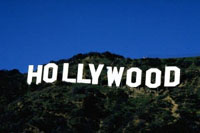American industries of all sorts — autos, textiles, steel and even software — are being battered by lower-cost competition from abroad. But the U.S. entertainment sector is poised to profit amid the onslaught, say Hollywood executive Jeff Berg and Wall Street investor Suhail Rizvi.
Granted, both men have their biases: They have placed big bets on Tinseltown. Berg, chairman of International Creative Management, a talent agency, has made his career in Hollywood; Rizvi, chief of Rizvi Traverse Management, a private equity firm, recently invested (along with Merrill Lynch) about $100 million in ICM.
But Berg and Rizvi’s partnership rests on clear-eyed strategic reasoning, not a shared fascination with the glittery side of the business. “The production of media may go to other places, but the content will still be owned by U.S. companies, and that’s where the value lies,” Rizvi says. In addition, people all over the world eat up American entertainment. Consider Harry Potter and the Goblet of Fire, the top-grossing movie of 2005. Produced by Warner Brothers, it made nearly $900 million, 70% of that abroad.
Berg and Rizvi spoke last month at the inaugural meeting of the Wharton undergraduate media and entertainment club. The initiative represents a shift for business schools, few of which focus on media and entertainment. Those that do tend to steer clear of the agency business, viewing it as “very schmoozy and who-you-know,” says Wharton marketing professor Peter Fader, “but times are changing fast.” The club is part of a Wharton effort to extend its research prowess into an industry that has historically seen little academic interest.
Fader, an adviser to the club, and Nelson Gayton, a Wharton adjunct professor, chose to kick off “uME,” as it’s called, by inviting Berg and Rizvi because agents act as gatekeepers for many media deals. “They sit in the middle of all the goings-on in the business,” Gayton notes. Berg’s firm represents not only actors, directors and writers, but also packages television programs like Sex in the City. And agencies stand to gain even as studios and record companies struggle with the challenges, like file sharing, created by digital content. Agents don’t care which distribution format wins because, Berg says, all of them are “new markets for us to sell into.”
The industry’s solid fundamentals mean that Berg shares little of the pessimism common among today’s entertainment executives. The average American consumes about 35 to 40 hours a week of media, ranging from music to video games, and the industry chalks up more than $75 billion in U.S. sales a year, he points out. “The United States is just a small piece of the business. Worldwide, it’s more than $1 trillion a year.” What’s more, entertainment assets, from movies to music, endure, as each generation discovers, say, Casablanca and The Rolling Stones. “There are vast catalogs of value that can be re-licensed into new channels.”
Digital Distribution
Still, traditional distributors of this content — conglomerates like Time Warner and Disney — face serious challenges, the most obvious being file-sharing. Attention there has centered on music, but “digital downloads don’t differentiate between audio and video,” Berg says.
The music industry has taken a “sue-the-customers” stance, trying to force file-sharing services out of business, Fader notes, adding that the original Napster may be gone, but the underlying problems remain. Digital technology won’t disappear, and consumers, especially younger ones, have demonstrated their dissatisfaction with the inconvenience and cost of compact discs. Fader sees solutions on the horizon, such as CDs offering both music and videos, but says that the industry hasn’t done much to promote such positive developments. “There’s been too much focus on sticks instead of carrots.”
Movie distributors haven’t found their predicament as tough. Berg suspects that’s because “it’s a pain to wait an hour and a half for a movie to download.” And unlike music companies, studios were quicker to embrace new channels, giving consumers more freedom to choose prices. Avid film fans can pay the most and see a movie in a first-run theater, while more frugal consumers can wait until it hits the second-run circuit, rent a DVD or opt for on-demand cable TV.
Forgotten in the debate about downloading is digital distribution’s ability to boost the entertainment industry, Berg says. “It drives cost out of the system. The movie industry spends $1 billion a year on [film] prints. Those costs are charged against your client…. With digital distribution, there are no prints.”
In addition, new channels represent new profit opportunities for adventurous actors, directors, writers and musicians. “Star talent wants the greatest level of exposure in all of the channels, and certain clients are always willing to experiment,” notes Berg. “I think it’s good to be first because you get some pricing advantage and maybe equity.” In late 2004, for example, the rock band U2 teamed up with Apple Computer to create a special U2-branded iPod and release a “digital boxed set” that could be loaded onto the music player.
One of the most promising new channels is mobile phones. Cellular providers are mixing and matching new services and devices, including combinations of phones and music players. Consumers, for their part, have shown that they will pay for phone-delivered entertainment: The market for ring tones is $3 billion to $5 billion a year, Rizvi says, noting that if consumers are willing to pay for a ring tone, “[they] will probably pay for original content.”
Berg predicts that phone customers will be able to purchase entertainment via subscription, rather than buying songs individually, for example. Assuming consumers accept that model, phone companies “will probably give you voice for free. It’s a commodity.”
Apple, Amazon and Other Players
What does all this mean for media giants such as Time Warner and Disney? Their future may not be as gloomy as some analysts have predicted.
For one thing, conglomerates will always exist, even if particular ones shrink or break up, Rizvi suggests. “Managers will always want to acquire companies, and entrepreneurs will always want to sell them.” Also, each big entertainment company has healthy assets to counterbalance its unhealthy ones, Berg says. Take Time Warner: Its AOL subsidiary is ailing, but profits from its cable operations are solid. The company’s underlying strength helped it fight off corporate raider Carl Icahn who, citing Time Warner’s slumping stock, had called for the company to be split up. But on February 17, Icahn and Time Warner boss Richard Parsons announced that they had ironed out their differences: The company will remain intact, keep cutting costs and ramp up its stock buybacks.
Disney last month cast its lot with one of the big players of digital. It bought Pixar Animation Studios from Steve Jobs, chief executive of both Pixar and Apple. Some commentators claimed that Disney had little choice but to embrace the famously creative, if mercurial, Jobs since its top box-office successes lately have come from the distribution of Pixar digital productions like Toy Story and Monsters, Inc. Tension between Jobs and former Disney chief Michael Eisner had strained that partnership.
However, Disney may find that it sold its soul to the devil. In saving itself, it may end up serving Jobs and Apple, Fader argues. “Being in bed with Apple hasn’t really helped the music industry. Steve Jobs just uses iTunes to sell iPods, not music. The site isn’t consumer friendly, and its pricing — 99 cents a song — is inflexible.” Apple lately has begun selling iPods equipped for video. That has spurred a rush by content providers to try and bring existing programs to the new format, Fader says.
Other media giants are diversifying their digital holdings, too. Last year, MTV, a division of Viacom, bought iFilm, an online video seller, and News Corp scooped up Intermix Media, owner of MySpace.com, a popular social-networking site, as well as about 30 other sites.
The increasing centrality of the web as a way to deliver entertainment leads Berg to predict that “the new major networks are going to be Google and Yahoo.” Google already has shown its willingness to battle with traditional publishers in its decision to digitize library books and make them available for online searching. Publishers are calling that copyright infringement. Google claims its aim is educational and thus protected by the fair-use doctrine. Both sides seem willing to fight in court, although Berg predicts that they will resolve their differences short of that. “My hunch is that Google’s brand is so powerful that the publishers and authors will have to get with them and figure it out.”
Another challenge for the entertainment industry comes from online retailer Amazon, which plans to sell music downloads. At one level, music distributors might welcome Amazon because it may be the only retailer that can compete online with Apple, Fader says. “At the same time, people in the industry have to be thinking, ‘Amazon’s not one of us, either.'”
As these challenges mount, a new generation of media leaders is taking control, and that shift likely augurs fundamental changes in the industry’s culture and cast of mind. Parsons has been head of Time Warner for only three years. Robert Iger replaced Eisner as Disney’s chief in October. Shari Redstone was recently tapped to replace her 82-year-old father, Sumner Redstone, as head of Viacom and CBS. And Brian Roberts, chief executive of Comcast, while president since 1990, is the youngest of the bunch, at 46.
New blood brings new ideas — something the entertainment industry needs, Gayton says. “Most of the people who ran Hollywood for a long time started in the mailrooms. It didn’t take a degree; it took a lot of chutzpah. Deals were done on the backs of envelopes. What’s happening is that all these new channels of distribution are placing more demands on executives, and we are seeing a changing of the guard.”



